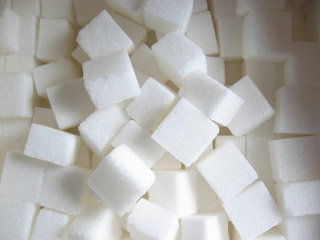Sugar Free Diet
A sugar free diet simply means eating no refined, concentrated, or added sugars. You can eat anything else.
Of course, candy and desserts are made with sugar. But did you know that refined sugar is a hidden ingredient in most processed foods? (Those are the foods in boxes and bags at your supermarket.)
To be sugar free, you need to read the ingredient lists on food labels, because refined sugars go by many different names. On this site you'll find a Names for Sugar list (almost 150 of them) that you can use for this purpose.
Sugar is addictive

Why is it so hard to follow a sugar free diet? Because refined sugar is addictive--literally!
It's thought to be the only food that can create an addiction that meets the criteria for physical dependence. Physical dependence includes binging, tolerance, sensitization, and physical withdrawal accompanied by intense cravings.
It's believed that sugar withdrawal is biologically similar to opiate withdrawal!
What to do?
My sugar withdrawal page describes the symptoms and causes, and discusses tapering and avoiding other food-related addictions.
The breaking sugar addiction page suggests how to break the cycle of craving and binging by substituting better foods.
I've also included some of my own sugar addiction story.
What's So Bad About Refined and Added Sugar?
Well-- it causes disease.
It's hard to see that for ourselves--because nearly everyone either eats refined sugar or used to. There's no one to compare ourselves to, so we never think of the effects of junk food.
I know I resisted the story of Sugar Blues, the classic presentation of how sugar affects us, which I wrote about here.
A Few Names For Refined Sugars
Refined sugars can have the same names as natural sugars, but don't be fooled! When they are used as ingredients--and therefore appear on ingredient lists--all are refined and unnatural food additives.
There are at least 150 names for sugar that I've collected!
Review the full list of the Names for Sugar
To create refined sugar, food manufacturers take whole natural foods and plants and (literally) cook them down to chemically pure sugar. The left over residue is discarded or used for animal feed.
Sucrose
Sugar cane and sugar beets are refined into white table sugar, which is chemically pure sucrose. Because of sugar's popularity over the centuries, there are many, many names for the pure and partially pure products of sugar cane and sugar beets.
Glucose, Dextrose, and Fructose
Corn is refined to create glucose, dextrose, and fructose ("fruit sugar"--yes, the "fructose" and "fruit sugar" seen on labels comes from corn). Corn, of course, is the source for corn syrup, which is also an industrially refined product.
High-fructose corn syrup is a mixture of refined glucose and refined fructose (both from corn) which is chemically so similar to sucrose (white table sugar) that it is typically used in processed foods in place of cane sugar.
Maltose
Barley and rice are refined to maltose. "Malted barley" and "brown rice syrup" sound harmless on ingredient lists, but, sadly, they are also a form of manufactured sugar.
Concentrated Fruit Juice
"Concentrated fruit juice," which is used as a sweetener in some processed foods, is also a form of manufactured sugar--but it's from a fruit source. Typically it is made from apples and pears.
Honey and Molasses
Commercially available honey and molasses, although having the same names as raw honey and unrefined molasses, are also refined.
What is sugar?
The word "sugar" has different meanings in different contexts--and unfortunately, different meanings in the Ingredient List part of the food label and the Nutrition Facts part of the food label.
You can read additional information about the different uses of the word "sugar" on my What is Sugar?page.
Ingredients List
Every sugar listed in the Ingredients list on the food label is added, as well as being either refined or concentrated.
For a sugar free diet, we're concerned about refined, concentrated, and added sugars. The World Health Organization calls them "free sugars" and defines them like this:
Free sugars: All monosaccharides and disaccharides added to foods by the manufacturer, cook, or consumer, plus sugars naturally present in honey, syrups, and fruit juices.
Nutrition Facts
The situation on the Nutrition Facts part of the food label is a little different.
"Sugars" is the conventional scientific term for two types of carbohydrates (monosaccharides and disaccharides). When a food is chemically analyzed for its food content--imagine a chemistry experiment--the amount of carbohydrates are calculated, and the amount of those carbohydrates that are sugars, are calculated.
The results are reported in Nutrition Facts as "Total Sugars."
Total Sugars = Sugars naturally occurring in food + Added sugars
In 2016, the FDA made changes to the Nutrition Facts label. Now, besides reporting "Total Sugars," it also separately reports "Added Sugars."
This will make it easier to spot at a glance when a packaged food has a lot of refined sugar--since all refined sugar is "added."
Sugar Substitutes
The sugar substitutes are considerably more unhealthy than sugar! I recommend they be avoided.
Artificial sweeteners are synthetic chemicals:
Acesulfame potassium
Aspartame
Neotame
Saccharin
Sucralose
Sugar alcohols are neither sugars nor alcohols; however, they are indigestible and notorious for causing diarrhea. They are frequently used in sugar-free desserts intended for diabetics. I did not soon forget the diarrhea caused by cookies made with mannitol.
Erythritol
Hydrogenated starch hydrolysates
Isomalt
Lactilol
Mannitol
Sorbitol
Xylitol
Whole foods and the sugar free diet
By eating whole foods, you automatically are spared refined sugar, sugar alcohols, artificial sweeteners, other food additives, and refined grains.
Any steps you take to eat better-quality, healthier foods, such as those described in Breaking Sugar Addiction, will help you avoid sugar withdrawal and increase your ability to maintain a sugar free diet.
